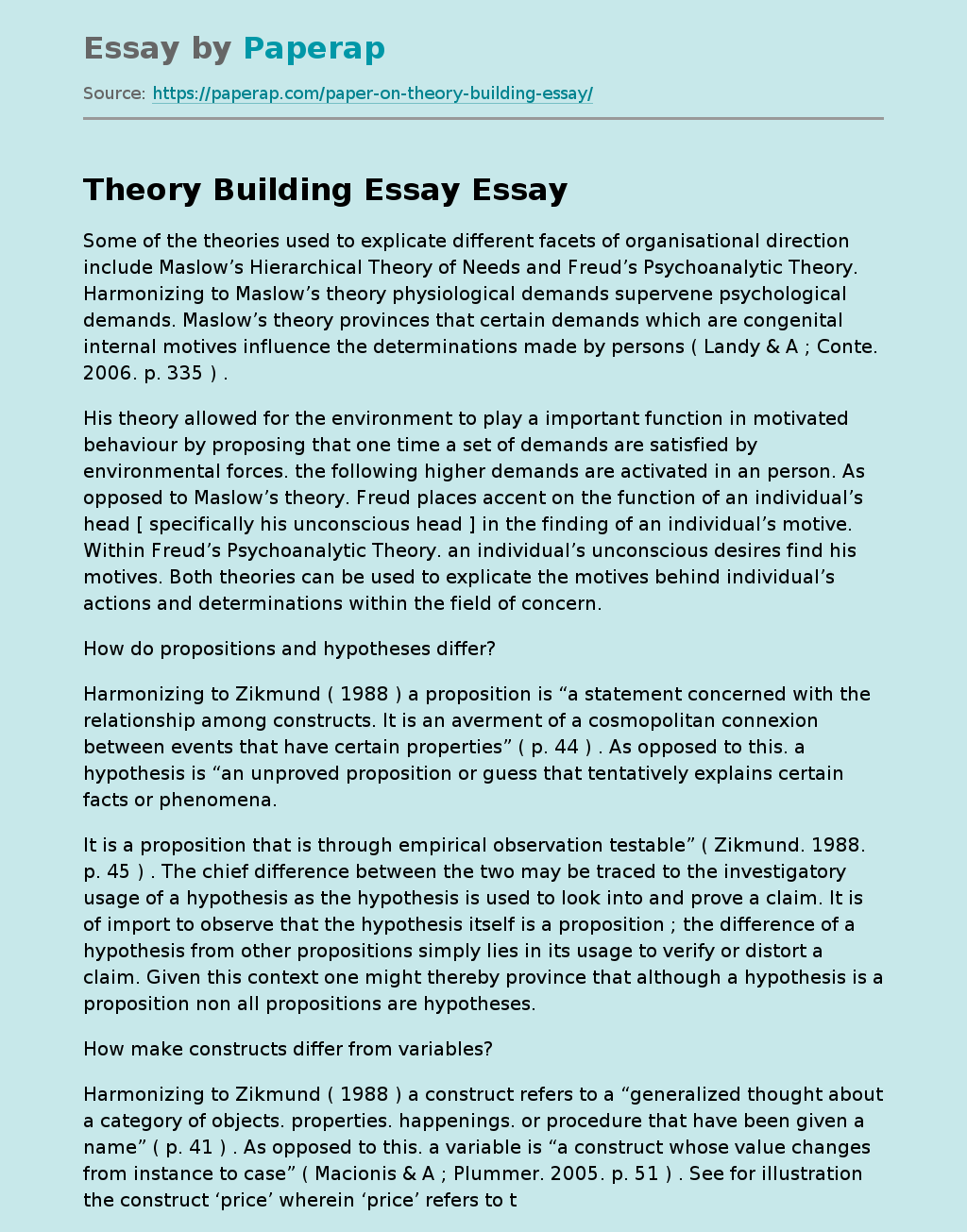Theory Building Essay
The following sample essay on some of the theories used to explicate different facets of organisational direction include Maslow’s Hierarchical Theory of Needs and Freud’s Psychoanalytic Theory. Harmonizing to Maslow’s theory physiological demands supervene psychological demands. Maslow’s theory provinces that certain demands which are congenital internal motives influence the determinations made by persons.
His theory allowed for the environment to play a important function in motivated behaviour by proposing that one time a set of demands are satisfied by environmental forces.
the following higher demands are activated in an person. As opposed to Maslow’s theory. Freud places accent on the function of an individual’s head [ specifically his unconscious head ] in the finding of an individual’s motive. Within Freud’s Psychoanalytic Theory. an individual’s unconscious desires find his motives. Both theories can be used to explicate the motives behind individual’s actions and determinations within the field of concern. How do propositions and hypotheses differ? Harmonizing to Zikmund ( 1988 ) a proposition is “a statement concerned with the relationship among constructs.
It is an averment of a cosmopolitan connexion between events that have certain properties”. As opposed to this. a hypothesis is “an unproved proposition or guess that tentatively explains certain facts or phenomena.
It is a proposition that is through empirical observation testable”. The chief difference between the two may be traced to the investigatory usage of a hypothesis as the hypothesis is used to look into and prove a claim. It is of import to observe that the hypothesis itself is a proposition ; the difference of a hypothesis from other propositions simply lies in its usage to verify or distort a claim.
Given this context one might thereby province that although a hypothesis is a proposition non all propositions are hypotheses. How make constructs differ from variables?
Harmonizing to Zikmund ( 1988 ) a construct refers to a “generalized thought about a category of objects. properties. happenings. or procedure that have been given a name”. As opposed to this. a variable is “a construct whose value changes from instance to case”. See for illustration the construct ‘price’ wherein ‘price’ refers to the value of an object. Within the context of the section shop. the ‘price’ of different objects differ from each other due to the differences of the factors used in finding the value of an object. In add-on to this although some constructs may match to a set of empirical steps. non all constructs do as opposed to variables that may match to two or more values. Remark on this statement: “There is nil every bit practical as a good theory. ” A theory refers to a “coherent set of general propositions used to explicate the evident relationships among certain ascertained phenomena”. Theories are of import as they provide a model for the analysis of a peculiar event. A theory may thereby supply an person with the necessary premises that may follow the ground for the happening of a peculiar event. In a sense. one might province that it provides an person with the causal account on how an event Q was caused by an event P.
It is necessary nevertheless that the theory used for the account is a good theory. A good theory here refers to a theory whose “empirical content is less than or equal to the ‘logical content’”. Such is the feature of a good theory since it ensures that the theory is through empirical observation verifiable and therefore testable. Given this context. there is nil every bit practical as a good theory since it ensures that one’s accounts for the happening of a peculiar event is continuously verifiable and hence testable and thereby easy proven to be valid easy. The 17th-century Dutch philosopher Benedict Spinoza said. “If the facts conflict with a theory. either the theory must be changed or the facts. ” Harmonizing to Spinoza. when facts conflict with a theory there is a necessity to either alter the theory or alter the facts in order to guarantee the theory’s cogency. A theory is either formulated through the usage of inductive logical thinking or deductive logical thinking. Deductive concluding refers to “the logical procedure of deducing a decision about a specific case based on a known general premiss or something known to be true”.
Inductive logical thinking. on the other manus. refers to the “the logical procedure of set uping a general proposition on the footing of observation of peculiar facts”. In the instance of a theory formulated utilizing a deductive statement. there is a demand to measure the cogency of propositions in order to guarantee the cogency and soundness of the statement. In the instance of inductive statements. the alteration or add-on of a proposition alterations the decision thereby taking to the alteration of the theory itself. Find another definition of theory. How is the definition you found similar to this book’s definition? How is it different?
Kerlinger ( 1979 ) defines a theory as “a set of interconnected concepts. definitions. and propositions that presents a systematic position of phenomenon by stipulating dealingss among variables. with the intent of explicating natural phenomena”. As opposed to this Zikmund ( 1988 ) defines a theory as a “coherent set of general propositions used to explicate the evident relationships among certain ascertained phenomena”. As can be seen above. both definitions note that a theory is composed of more abstract constituents in the signifier of propositions wherein each proposition is interrelated in such a manner that when combined together they formulate one coherent and systematic worldview. The difference of Kerlinger’s definition nevertheless may be traced to his add-on of what a theory is seeking to explicate that being ‘natural phenomena’ . Hence. Zikmund’s definition may be seen as showing a wide definition of a theory whereas Kerlinger narrows his definition by saying what a theory refers to.
Theory Building Essay. (2017, Aug 25). Retrieved from https://paperap.com/paper-on-theory-building-essay/

